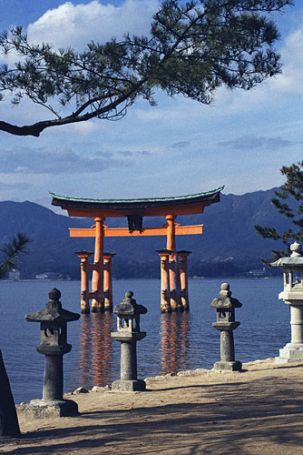
To come by early morning boat across the mist-enshrouded sea, slowly approaching the island and its sacred mountain of Misen San, is to enter a fairy tale realm. Long before Buddhism came to Japan in the 5th century AD, Shinto sages lived as hermits in the mountain’s forested hills. Today the small island of only 12 square miles is much visited by pilgrims and tourists yet still retains its extraordinary sense of serenity and magic.
Blanketed with luxuriant primeval forests, Misen San is the highest peak on Miyajima Island, rising to 1739 feet (530 meters). From its lofty summit there is a panoramic view of many other islands in the Seto Inland Sea and the distant mountain ranges of Shikoku. Near the summit are a few small temples including the Gumonjido, a temple founded in the early 9th century AD by the great sage Kobo Daishi on his return from China. A flame burning within the temple has burned consistently from the time of the temple's dedication to the present. There is an aerial cable car to the summit but it is more enjoyable to walk along one of the three paths through the forests. The Omoto path is the most beautiful and the least used; strolling here you will feel yourself transported back to the semi-mythical days of Kobo Daishi and the Shinto mountain mystics. The peaceful forests of Misen San are also home to some two thousand domesticated deer.
Miyajima’s primary temple, the Itsukushima shrine, was first constructed in 593 AD and later enlarged to its present size in 1168. One of the world’s most extraordinary examples of sacred architecture, it is listed as a National Treasure with the government of Japan. The complex of buildings includes the main shrine, several subsidiary temples, a Noh drama and dance stage, and many bridges and walkways linking the various parts of the temple. Built on tidal land and giving the appearance of floating on the sea during high tide, the shrine is dedicated to three Shinto goddesses of the sea; Ichikishima, Tagori, and Tagitsu, each of whom is believed to live within the inner sanctum of the shrine. Metal nails were not used in the construction of the buildings and there are precisely calculated crevices between the floor slabs in order to alleviate the pressure of high tidal waves caused by typhoons. Some of the ancient wooden planks used for flooring are 1.5 meters wide and over 10 meters long, and these enormous boards were laboriously transported to Miyajima from hundreds of miles away in northern Japan.
Adjacent to the Itsukushima temple is the Hokoku shrine. An inner part of this shrine, known as the Senjokaku, was constructed by the fabled Japanese warrior Hideyoshi Toyotomi for the repose of the souls of war dead. The five-storied pagoda, 27 meters tall, is believed to have been built in 1407 and represents a harmonious combination of Chinese and Japanese architectural styles. Within the pagoda, painted in full color, is a beautiful image of the Buddha.
The lovely Otorri gate, standing in the sea and leading to the Itsukushima shrine, is the symbol of Miyajima Island. The present Otorii, the eighth constructed since the Heian period (794-1192), was built in 1875 with the wood of camphor trees. It is 16 meters tall, the roof is 24 meters long, and the main pillars, made from single trees, are 10 meters in circumference. The Otorii stands on its own support, having no part buried in the ground. During the mid-July Kangensai music festival, colorfully decorated boats sail through the giant gate while dancers aboard the boats perform sacred dances. Associated with the Itsukushima shrine, and considered a part of its sacred geography, are seven smaller shrines positioned around the 19-mile circumference of the island. There are no roads to most of these shrines therefore pilgrims use small boats to approach the rocky shores where the temples are located.


























